Assessment of 210Po, 210Bi and 210Pb in aerosols and their deposition fluxes in the nearshore region of the East China Sea
-
摘要: 大气210Po、210Bi和210Pb的沉降通量是海洋中核素示踪颗粒物动力学过程(颗粒有机碳输出、颗粒物输运)的基础参数,为揭示我国近海地区210Po、210Bi和210Pb活度浓度的时空变化规律并估算其沉降入海通量,本文于2016年9月至翌年2月和2021年9−11月分别对上海及厦门地区近地表大气气溶胶中210Po、210Pb和210Bi的活度浓度进行了连续观测;基于210Po-210Pb活度比(210Po/210Pb)和210Bi-210Pb活度比(210Bi/210Pb)两种示踪法计算了气溶胶颗粒物的滞留时间,并利用一维简单气溶胶沉降速率模型估算了3种核素以大气沉降方式输入东海的通量。结果显示,2016年上海秋、冬两季210Po、210Bi、210Pb 3种核素活度浓度的变化范围分别为0.11~1.27 mBq/m3、0.45~1.83 mBq/m3和1.12~6.10 mBq/m3;2021年秋季厦门210Po、210Bi、210Pb 3种核素活度浓度的变化范围分别为0.05~0.85 mBq/m3、0.83~2.52 mBq/m3和0.17~1.32 mBq/m3,上海近地表气溶胶中3种核素的活度浓度秋季平均值比厦门地区高。利用210Po/210Pb和210Bi/210Pb计算得到上海和厦门近地面大气的气溶胶滞留时间存在显著差异,基于210Po/210Pb计算上海气溶胶滞留时间均值为(94 ± 54)d,基于210Bi/210Pb计算上海气溶胶滞留时间均值为(6.4 ± 4.8)d,造成这种差异的原因很可能是两种示踪法本身具有的系统性差异。本文基于一维简易气溶胶沉降速率模型估算了上海地区的210Pb、210Bi和210Po的大气沉降入东海的通量,其在秋季期间的变化范围分别为0.1~26.35 Bq/(m2·d)、0.04~7.91 Bq/(m2·d)和0.01~5.49 Bq/(m2·d)。基于模型估算的210Po、210Bi和210Pb沉降通量与研究区域的实际观测值接近一致,表明利用一维简易气溶胶沉降速率模型间接估算法在替代观测站直测核素的沉降入海通量方面具有一定可行性。Abstract: The deposition fluxes of 210Po, 210Bi and 210Pb in atmosphere are the basis for the application of radionuclide tracing in the ocean. In order to reveal the spatio-temporal variation of the activity of 210Po, 210Bi and 210Pb in nearshore areas and estimate their deposition fluxes into the sea, in this paper, sampling observation and analysis of two typical areas near the East China Sea in Shanghai and Xiamen in different periods are carried out. A time series study was conducted on the the aerosol activities of 210Po, 210Pb and 210Bi in Shanghai and Xiamen from September 2016 to February 2017 and from September to November 2021, respectively. The residence time of aerosol particle was calculated based on 210Po/210Pb and 210Bi/210Pb. Deposition fluxes of three nuclides were also estimated. This paper reported the activity of 210Po, 210Bi and 210Pb in Shanghai in autumn and winter of 2016. The activity ranges of 210Po, 210Pb and 210Bi were 0.11−1.27 mBq/m3, 0.45−1.83 mBq/m3 and 1.12−6.10 mBq/m3, respectively. In the fall of 2021, the activity ranges of 210Po, 210Bi and 210Pb in Xiamen were 0.05−0.85 mBq/m3, 0.83−2.52 mBq/m3 and 0.17−1.32 mBq/m3, respectively. The aerosol activity of each nuclide in Shanghai was higher than that in Xiamen. The estimated residence time based on 210Po-210Pb and 210Bi-210Pb methods are significantly different, for example, in Shanghai area, the averaged aerosol residence time based on 210Po-210Pb method was calculated to be (94 ± 54) d, which is much higher than the result from 210Bi-210Pb method. The main reason for this difference is most likely due to the difference in the properties of the tracing isotopes we used. In this paper, based on a one-dimensional simple aerosol deposition rate model, the atmospheric deposition fluxes of 210Pb, 210Bi and 210Po over Shanghai area into the East China Sea are estimated, and their variation ranges are 0.1−26.35 Bq/(m2·d), 0.04−7.91 Bq/(m2·d) and 0.01−5.49 Bq/(m2·d), respectively. The deposition fluxes of 210Po, 210Bi and 210Pb estimated based on the model are close to the actual observed values in the study area during the same period in winter within a certain range. The feasibility of estimating the deposition flux of nuclide into the sea with a simple one dimensional aerosol deposition rate model is verified.
-
Key words:
- nearshore region of the East China Sea /
- 210Po /
- 210Bi /
- 210Pb /
- residence time /
- deposition flux
-
1. 引言
放射性核素应用于地球和环境科学已有超过150年的历史,如210Po、210Pb和210Bi 等放射性核素示踪剂在帮助理解小至细胞尺度和大至海盆尺度的环境过程均能提供独一无二的视角[1]。由于210Po和210Pb具有不同的地球化学特性和来源,海洋环境中普遍存在着显著的210Po-210Pb活度不平衡现象[2],这种现象提供了有关沉积物沉积速率和海洋生物摄取过程的重要信息,对于理解海洋环境和生物学过程具有重要意义,因此利用天然存在的210Po-210Pb核素成为解决海洋上层水体碳输出通量的重要研究手段[3–8]。
然而,210Po-210Pb 活度不平衡法作为一种较新的颗粒有机碳(Particulate Organic Carbon, POC)输出通量评估方法,在实际的使用中还存在一些问题亟待解决,其中一个重要的问题是海洋中大气沉降的210Pb、210Bi和210Po通量是否应该忽略。国际上利用210Po-210Pb法示踪海洋POC输出通量的研究,主要集中于大洋、极地等偏远海域,由于研究人员无法获得相关研究区域210Po和210Pb的大气沉降通量数值,因此在构建评估模型时,常常忽略210Po和210Pb的大气沉降通量[9–12]。对于远离大陆以及不受大江大河影响的远海,大气沉降输送的210Pb、210Bi和210Po是除226Ra母体衰变之外仅有的另一来源,此时大气沉降贡献的210Pb及其子体占所有来源的百分比将显著提高。另外,地球上某些区域210Pb的大气沉降通量远高于全球平均水平,比如位于北美洲的美国东海岸及墨西哥湾地区和包括中国在内的东亚地区[13]。因此,南海、东海、黄海、渤海和西北太平洋及其边缘海(日本海、鄂霍茨克海)等在内的东亚海区,210Pb及其子体的大气沉降通量相比其他海区应该更加重要,可见在利用210Po-210Pb核素对进行海洋动力学过程的示踪应用时,了解大气气溶胶中210Pb及其子体(210Bi和210Po)浓度、分布以及大气沉降过程等是必要的前期工作。
受限于实验条件、研究成本和船时等实际情况,目前难以实现在外海和大洋搭建海上观测站用于直接测定210Pb、210Bi和210Po的大气沉降通量。一种行之有效的替代法是在沿海地区建立观测站,通过气溶胶中210Pb及其子体的活度浓度以及气溶胶颗粒的沉降速率间接推算210Pb及其子体的大气沉降入海通量。本文首次报道了东海近岸地区(上海和厦门)气溶胶中3种核素的活度浓度观测结果,进一步,本文估算了气溶胶的滞留时间以及210Pb、210Bi和210Po通过大气沉降方式输入东海的通量。本文的研究结果将为后续在东海以及其他东亚海区210Po、210Bi和210Pb的示踪应用提供必要的基础参数。
2. 材料和方法
2.1 气溶胶样品的采集和前处理
气溶胶采样站位位置:上海地区观测站位经纬度为31.22°N,121.39°E;厦门地区观测站位经纬度为24.44°N,118.09°E。上海地区气溶胶采样设备固定在上海市普陀区华东师范大学河口海岸大楼六楼楼顶(距离地面约20 m),距离东海约50 km,采样时段为2016年9月至翌年2月;厦门地区气溶胶采样设备固定在厦门市思明区自然资源部第三海洋研究所放化楼顶(距离地面约15 m),距离厦门湾约50 m,采样时段为2021年9−11月。气溶胶样品是由美国Clover公司生产的便携式Staplex TF1A型大流量空气采样器采集。其单台采样器的最大流量可达2 m3/min。气溶胶滤膜为英国Whatman公司生产的石英纤维滤膜(QMA膜),孔径为2.2 μm,该膜对0.3 μm邻苯二甲酸二辛酯(DOP)截留效率大于99.995%,可以保证高效的截留气溶胶粒径大于2.5 μm的大气颗粒物。每次换样,将已称重的干净滤膜固定于空气采样器内部,采样时间为24~48 h。记录样品采集时间、体积,最后称重。
2.2 样品处理与核素测量
气溶胶中210Po和210Bi的分析处理流程简述如图1所示。裁剪样品膜面积的1/10转移到干净的Teflon烧杯中,加入209Po(0.03 Bq)和207Bi(0.5 Bq)示踪剂后进行消解。随后用镍片进行自沉积反应[14]。室温自沉积16 h后,209Po和210Po以及Bi同位素会最大效率的自沉积在镍片上[3]。之后将镍片封装,并放入超低本底五路β计数器(丹麦科技大学生产,型号为GM-25-5A)进行多次测量获得210Bi;再将镍片置于高纯锗γ能谱仪中测定207Bi的回收率并将其作为210Bi的化学回收率[15],用已知活度的210Pb-210Bi-210Po平衡液自制210Bi标准源测量得到210Bi的测量效率。210Po活度浓度利用超低本底alpha能谱仪(型号为7200-08,Canberra公司)测量,210Po的活度浓度根据已知活度209Po作为内标示踪剂计算得到。气溶胶中的210Pb的活度浓度通过210Po-210Pb平衡法进行测定[16–17]。
2.3 210Po、210Bi和210Pb活度的计算
采样时刻气溶胶中210Bi的活度浓度需要进行校正。第一次自沉积时刻(t1)镍片上210Bi的活度浓度[
$A_{{}^{210}{\mathrm{Bi}}} $ (t1),单位:mBq/m3]为$$ {A}_{{}^{210}\mathrm{B}\mathrm{i}}\left({t}_{1}\right)=\frac{{N}_{{\text{βi}}}}{{\eta }_{{\mathrm{Bi}}}{Y}_{{\mathrm{Bi}}}V}\text{,} $$ (1) 式中,Nβi为扣除背景计数率后的总β净计数率;V表示气溶胶的采样体积(单位:m3);ηBi为β计数器对镍片上210Bi的探测效率;YBi为γ能谱仪测得207Bi的回收率,即210Bi的化学回收率。采样时刻气溶胶中210Bi的活度浓度[
$A_{{}^{210}{\mathrm{Bi}}} $ (t0),单位:mBq/m3]校正公式如下:$$ {A}_{{}^{210}\mathrm{B}\mathrm{i}}\left({t}_{0}\right)={A}_{{}^{210}\mathrm{B}\mathrm{i}}\left({t}_{1}\right)-\frac{{\lambda }_{{\mathrm{Bi}}}}{{\lambda }_{{\mathrm{Bi}}}-{\lambda }_{{\mathrm{Pb}}}}{A}_{{}^{210}{\mathrm{Pb}}}\left({t}_{0}\right){\mathrm{e}}^{{\lambda }_{{\mathrm{Bi}}}{T}_{1}}\left({{\mathrm{e}}}^{-{\lambda }_{{\mathrm{Pb}}}{T}_{1}}-{{\mathrm{e}}}^{-{\lambda }_{{\mathrm{Bi}}}{T}_{1}}\right) \text{,} $$ (2) 式中,
${{A}}_{{}^{210}{\mathrm{Pb}}} $ (t0)为通过式(1)计算得到的采样时刻的210Pb活度浓度;λBi为210Bi的衰变常数(0.138 4 d−1);T1为采样时刻与自沉积结束时刻之间间隔的时间(单位:d)。采样时刻气溶胶中210Po的活度浓度同样需要进行衰变和内生长校正。开始测量时刻镍片上210Po的活度浓度[
$A_{{}^{210}{\mathrm{Po}}} $ (t1)]为$$ {{A}}_{{}^{210}{\mathrm{Po}}}\left({t}_{1}\right)=\frac{{N}_{{}^{210}{\mathrm{Po}}}\left({t}_{1}\right)}{{N}_{{}^{209}{\mathrm{Po}}}\left({t}_{1}\right)}\times {A}_{{}^{209}{\mathrm{Po}}}\times \frac{1}{V}\text{,} $$ (3) 式中,
$A_{{}^{209}{\mathrm{Po}}} $ 为消解时加入的209Po示踪剂活度;N为alpha能谱仪中特征峰面积。因此,采样时刻气溶胶中210Po的活度浓度为$$ \begin{split}{A}_{{}^{210}{\mathrm{Po}}}\left({t}_{0}\right)=&{A}_{{}^{210}{\mathrm{Po}}}\left({t}_{1}\right){\mathrm{e}}^{{\lambda }_{\mathrm{Po}}{T}_{2}}-{A}_{{}^{210}{\mathrm{Bi}}}\left({t}_{0}\right){\mathrm{e}}^{{\lambda }_{{\mathrm{Po}}}{T}_{1}}\left[\frac{{\lambda }_{\mathrm{Po}}}{{\lambda }_{\mathrm{Po}}-{\lambda }_{\mathrm{Bi}}}{\mathrm{e}}^{-{\lambda }_{\mathrm{Bi}}{T}_{1}}+\right.\\ &\left.\frac{{\lambda }_{\mathrm{Po}}}{{\lambda }_{\mathrm{Bi}}-{\lambda }_{\mathrm{Po}}}{\mathrm{e}}^{-{\lambda }_{\mathrm{Po}}{T}_{1}}\right]-{A}_{{}^{210}{\mathrm{Pb}}}\left({t}_{0}\right){\mathrm{e}}^{{\lambda }_{\mathrm{Po}}{T}_{1}}{\lambda }_{\mathrm{Bi}}{\lambda }_{\mathrm{Po}}\times\\ &\left[\frac{{\mathrm{e}}^{-{\lambda }_{\mathrm{Pb}}{T}_{1}}}{\left({\lambda }_{\mathrm{Bi}}-{\lambda }_{\mathrm{Pb}}\right)\left({\lambda }_{\mathrm{Po}}-{\lambda }_{\mathrm{Pb}}\right)}+\frac{{\mathrm{e}}^{-{\lambda }_{\mathrm{Bi}}{T}_{1}}}{\left({\lambda }_{\mathrm{Pb}}-{\lambda }_{\mathrm{Bi}}\right)\left({\lambda }_{\mathrm{Po}}-{\lambda }_{\mathrm{Bi}}\right)}+\right.\\ &\left.\frac{{\mathrm{e}}^{-{\lambda }_{\mathrm{Po}}{T}_{1}}}{\left({\lambda }_{\mathrm{Pb}}-{\lambda }_{\mathrm{Po}}\right)\left({\lambda }_{\mathrm{Bi}}-{\lambda }_{\mathrm{Po}}\right)}\right] \text{,}\\[-12pt] \end{split}$$ (4) 式中,T2为自沉积结束时刻与测量alpha能谱之间间隔的时间(单位:d);λPo为210Po的衰变常数(2.01×10−3 d−1)。其他变量的表示意义同上。
存放1.5年后,气溶胶中210Po和210Pb的活度接近平衡,此时210Pb的活度浓度计算公式为
$$ {A}_{{}^{210}\mathrm{P}\mathrm{b}}\left({t}_{0}\right)=\frac{{N}_{{}^{210}\mathrm{P}\mathrm{o}}\left({t}_{2}\right)}{{N}_{{}^{209}\mathrm{P}\mathrm{o}}\left({t}_{2}\right)}\times {A}_{{}^{209}\mathrm{P}\mathrm{o}}\times \frac{1}{V}\times {\mathrm{e}}^{{\lambda }_{\mathrm{P}\mathrm{b}}\left({t}_{2}-{t}_{0}\right)}\text{,} $$ (5) 式中,
$A_{{}^{210}{\mathrm{Pb}}} $ (t0)为采样时刻210Pb的活度浓度(单位:mBq/m3);N$_{{}^{210}{\mathrm{Po}}} $ (t2)和N$_{{}^{209}{\mathrm{Po}}} $ (t2)分别为第二次自沉积时样品谱图中210Po峰面积和209Po的峰面积;t2−t0为样品第二次自沉积时刻(t2)和采样时刻(t0)之间间隔的时间(单位:d);λPb为210Pb的衰变常数(8.54 × 10−5 d−1)。3. 结果和讨论
3.1 东海近岸近地面气溶胶中210Po、210Bi和210Pb的活度浓度以及活度比特征
由图2可知,2016年9月至翌年2月期间(秋、冬季)东海典型近岸上海地区近地面大气中大气总悬浮颗粒物(Total Suspended Particle, TSP)的含量变化范围为77~316 μg/m3,平均值为(170 ± 85)μg/m3(n = 10),上海地区近地面大气中210Po、210Bi和210Pb的活度浓度变化范围分别为0.11~1.27 mBq/m3、0.45~1.83 mBq/m3和1.12~6.10 mBq/m3,3种核素活度浓度的算术平均值(±标准偏差)分别为(0.63 ± 0.33)mBq/m3、(0.92 ± 0.50)mBq/m3和(2.51 ± 1.36)mBq/m3。对比来看,气溶胶中210Pb的活度浓度最高,约为210Bi活度浓度的3倍;210Po活度浓度最低。在此期间,上海地区近地面大气中210Po/210Pb的变化范围为0.10~0.49,均值为0.26 ± 0.12;而210Bi/210Pb的变化范围为0.08~0.80,均值为0.41 ± 0.18。可见,东海近岸的上海地区近地面大气中均存在强烈的210Po相对于210Pb活度亏损和210Bi相对于210Pb活度亏损的现象,相较而言,210Po-210Pb活度亏损程度(210Po/210Pb = 0.26)显著强于210Bi-210Pb(210Bi/210Pb = 0.41)(210Bi/210Pb和210Po/210Pb的显著性检验为p = 0.03 < 0.05)。
同为地处东海近岸的厦门地区,2021年9月至11月期间(秋季),近地面大气中TSP的含量变化范围为23~123 μg/m3,平均含量为(66 ± 27)μg/m3(n = 11)。210Po、210Bi和210Pb活度浓度的变化范围为0.05~0.85 mBq/m3、0.83~2.52 mBq/m3和0.17~1.32 mBq/m3;均值分别为(0.18 ± 0.25)mBq/m3、(1.21 ± 0.82)mBq/m3和(0.71 ± 0.27)mBq/m3。而210Po/210Pb和210Bi/210Pb活度比的变化范围分别为0.1~0.78和1.30~1.96,平均值分别为0.26 ± 0.22和1.54 ± 0.47(表1)。
表 1 东海近岸近地面大气气溶胶中210Po、210Bi和210Pb的活度浓度及活度比Table 1. Activities concentration and activity ratios of 210Po, 210Bi and 210Pb in near-surface atmospheric aerosols close to the East China Sea东海近岸 样品名 采样时间 体积/
m3TSP含量/
(μg·m−3)210Po活度浓度/
(mBq·m−3)210Bi活度浓度/
(mBq·m−3)210Pb活度浓度/
(mBq·m−3)210Po/210Pb 210Bi/210Pb 上海地区 201609-SHA 2016年9月22−23日 1 642 170 0.92 ± 0.08 NA 3.23 ± 0.25* 0.28 ± 0.03 NA 201610-SHA 2016年10月17−18日 2 206 105 0.58 ± 0.03 0.62 ± 0.02 1.41 ± 0.14* 0.41 ± 0.05 0.44 ± 0.02 201611-SHA-1 2016年11月5−6日 2 571 137 0.59 ± 0.04 0.95 ± 0.03 2.00 ± 0.16* 0.30 ± 0.03 0.48 ± 0.02 201611-SHA-2 2016年11月14−15日 2 307 152 1.27 ± 0.10 1.83 ± 0.12 2.61 ± 0.18* 0.49 ± 0.05 0.70 ± 0.05 201611-SHA-3 2016年11月19−20日 1 462 251 0.83 ± 0.05 1.47 ± 0.07 2.75 ± 0.22* 0.30 ± 0.03 0.53 ± 0.03 201612-SHA-1 2016年12月5−6日 1 320 303 0.66 ± 0.09 NA 2.56 ± 0.18* 0.26 ± 0.04 NA 201612-SHA-2 2016年12月23−24日 1 440 316 0.77 ± 0.05 0.51 ± 0.03 6.10 ± 0.53* 0.13 ± 0.01 0.08 ± 0.01 201701-SHA-1 2017年1月3−4日 1 264 84 0.42 ± 0.03 0.59 ± 0.02 1.89 ± 0.15* 0.22 ± 0.02 0.31 ± 0.02 201701-SHA-2 2017年1月12−13日 1 200 101 0.16 ± 0.01 0.45 ± 0.03 1.40 ± 0.12* 0.11 ± 0.01 0.32 ± 0.03 201702-SHA 2017年2月23−24日 1 333 77 0.11 ± 0.01 NA 1.12 ± 0.10* 0.10 ± 0.01 NA 厦门地区 21XMA-1 2021年9月27−28日 1133 69 0.85 ± 0.04 2.52 ± 0.11 1.32 ± 0.10 0.78 ± 0.06 1.96 ± 0.18 21XMA-2 2021年10月2−3日 1 121 51 0.14 ± 0.01 1.29 ± 0.07 0.80 ± 0.06 0.19 ± 0.02 1.30 ± 0.12 21XMA-3 2021年10月5−6日 1 175 68 0.21 ± 0.01 0.83 ± 0.04 0.53 ± 0.04 0.43 ± 0.03 1.36 ± 0.13 21XMA-4 2021年10月10−11日 1 135 42 0.11 ± 0.01 NA NA NA NA 21XMA-5 2021年10月11−12日 1 263 98 0.08 ± 0.02 NA 0.17 ± 0.10 0.54 ± 0.12 NA 21XMA-6 2021年10月16−17日 1 206 80 0.05 ± 0.02 NA 0.26 ± 0.02 0.23 ± 0.07 NA 21XMA-7 2021年10月23−24日 1 222 23 0.09 ± 0.01 NA 0.41 ± 0.04 0.24 ± 0.03 NA 21XMA-8 2021年10月30−31日 1 484 81 0.10 ± 0.02 NA 1.07 ± 0.07 0.10 ± 0.02 NA 21XMA-10 2021年11月13−14日 1 589 56 0.16 ± 0.01 NA 0.93 ± 0.08 0.19 ± 0.02 NA 21XMA-11 2021年11月20−21日 1 520 123 0.13 ± 0.01 NA 0.76 ± 0.05 0.18 ± 0.02 NA 21XMA-12 2021年11月27−28日 1 620 40 0.06 ± 0.01 NA 0.50 ± 0.05 0.13 ± 0.01 NA 注:*代表气溶胶中210Pb的活度浓度引自文献[17];NA表示“未获得”。 上海近地面大气中210Po和210Pb的活度浓度均值约是厦门的3倍。影响近地面大气中核素活度浓度的因素包括大气混合程度的强弱、工业和交通等人为活动的强弱、受海洋性气团影响的强弱等。因此,厦门地区气溶胶中210Po、210Bi和210Pb活度浓度显著低于上海地区的原因有:(1)海洋性气团具有低核素活度浓度的属性[15],厦门地区的观测站距海仅数10 m远,而上海地区的观测站距海约50 km,因此位于厦门的观测站受到来自东海的海洋性气团的影响将显著强于位于上海的观测站;(2)观测期间上海地区空气中悬浮颗粒物含量约为厦门地区的3倍,表现出强烈的雾霾事件信号[16],而厦门秋季近地面大气TSP含量远低于上海地区,且观测期间厦门地区的空气污染指数并未达到污染水平;(3)上海地区报道的数据为新冠病毒大流行前的结果,而厦门地区报道的数据为新冠病毒疫情影响下的结果。由于疫情管控等措施的影响,人为活动强度降低带来的大气排放(包括燃煤源、机动车源、生物质燃烧源等排放)[18]降低也是厦门地区气溶胶210Pb、210Bi和210Po活度浓度低于上海地区的重要因素。
表2整理了当前全球各地对气溶胶中210Pb、210Bi和210Po活度浓度的观测结果,并对比了秋冬季节3种核素活度浓度结果。近地面秋冬季大气中210Po活度浓度由大到小依次为:上海(0.63 ± 0.33)、厦门(0.21 ± 0.25)、美国波克福莱特(0.100 ± 0.052)、美国伊戈尔岛(0.037 ± 0.015)、美国底特律(0.03 ± 0.019)、葡萄牙里斯本(0.024 ± 0.01)。210Bi活度浓度由大到小依次为:厦门(1.55 ± 0.82)、上海(0.92 ± 0.50)、美国底特律(0.35 ± 0.20)、葡萄牙里斯本(0.12 ± 0.07)、美国橡树岭国家实验室(0.08 ± 0.06)。210Pb活度浓度由大到小依次为:上海(2.51 ± 1.36)、印度坎普尔(1.80 ± 1.10)、美国波克福莱特(0.92 ± 0.10)、美国底特律(0.85 ± 0.49)、伊戈尔岛(0.37 ± 0.12)、美国橡树岭国家实验室附近(0.19 ± 0.08)、葡萄牙里斯本(0.16 ± 0.11)。通过上述对比,可以发现,与全球其他地区秋冬季报道的结果相比,上海和厦门地区近地面大气气溶胶中210Po、210Bi和210Pb活度浓度均处于全球较高水平,这符合Zhang等[13]得出的亚洲核素浓度值偏高的结论,原因是秋冬季东海典型近岸区主导风向会将大量内陆细颗粒物传输至海岸带地区,进而导致大气中颗粒物浓度偏高,有利于更多地吸收大气中的相关核素,东海沿海近地面大气中的210Pb、210Bi和210Po的活度浓度比内陆城市底特律更高。
表 2 全球各地区气溶胶中210Po、210Bi和210Pb的活度浓度大小对比Table 2. Comparison of 210Po activity concentration, 210Bi activity concentration and 210Pb activity concentration in aerosols from different regions of the world地区 海拔/m 年降水量/
mm观测时间 210Pb活度浓度/(mBq·m−3) 210Bi活度浓度/(mBq·m−3) 210Po活度浓度/(mBq·m−3) 文献 范围 平均值 范围 平均值 范围 平均值 上海 约20 1 260 2016年9月至翌年2月 1.12~6.10 2.51 ± 1.36 0.45~1.83 0.92 ± 0.50 0.11~1.27 0.63 ± 0.33 本文 厦门 约15 1 464 2021年9−11月 0.17~1.24 0.67 ± 0.05 0.83~2.52 1.55 ± 0.82 0.06~0.97 0.21 ± 0.25 本文 美国底特律 约15 851 2017年9月至翌年1月 0.18~2.23 0.85 ± 0.49 0.06~0.81 0.35 ± 0.20 0.010~0.096 0.03 ± 0.019 文献[15] 美国橡树岭
国家实验室约25 − 1984年10月至翌年2月 0.14~0.27 0.19 ± 0.08 0.06~0.11 0.08 ± 0.06 − − 文献[22] 葡萄牙里斯本 25 1 000 1986年1月至
1989年12月(秋冬季)0.04~0.42 0.16 ± 0.09 0.01~0.27 0.12 ± 0.07 0.003~0.171 0.024 ± 0.01 文献[21] 印度坎普尔 约142 810 2007年1月至2009年4月 0.50~4.80 1.80 ± 1.10 − − 0.002~0.28 0.094 文献[23] 美国波克福莱特 近地面 1 119 1996年1−2月 0.82~1.02 0.92 ± 0.10 − − 0.048~0.152 0.100 ± 0.052 文献[24] 美国伊戈尔岛 近地面 − 1996年1−3月 0.22~0.55 0.37 ± 0.12 − − 0.018~0.059 0.037 ± 0.015 文献[24] 将表2文献中报道的全球各观测站位获得的数据汇总后绘制出如图3所示的全球空间分布。从空间分布上看,并未表现出明显的分布规律,且3种核素与降雨量无关,除厦门和上海外,印度坎普尔的210Pb和210Po活度浓度也表现出高值,这是该地区PM2.5高值和热带季风气候所致[19–20];葡萄牙里斯本是典型的海洋城市,且主要受大西洋暖流影响,故核素浓度在这几座城市中最低[21]。上述现象表明,不同地区近地表气溶胶中核素的活度浓度大小与所处地理位置和气候条件有关。
3.2 东海典型近岸区域气溶胶颗粒物的滞留时间
大气颗粒物中核素活度浓度及其停留时间均是描述自身状况的一种属性,除了了解核素活度浓度及时空分布特征外,停留时间也是影响颗粒物沉降入海的重要因素。通过测定气溶胶颗粒物上210Po/210Pb和210Bi/210Pb活度比特征能够有效地帮助评估气溶胶在大气中的滞留时间。而近岸气溶胶的滞留时间能很好地反映大气颗粒物沉降入海的贡献。
基于210Bi/210Pb计算气溶胶滞留时间(τBi-Pb)的公式[25–27]为
$$ {\tau }_{\mathrm{B}\mathrm{i}{\text{-}}\mathrm{P}\mathrm{b}}=\frac{1}{{\lambda }_{\mathrm{B}\mathrm{i}}}\times \frac{{R}_{\mathrm{B}\mathrm{i}/\mathrm{P}\mathrm{b}}}{\left(1-{R}_{\mathrm{B}\mathrm{i}/\mathrm{P}\mathrm{b}}\right)} \text{,} $$ (6) 式中,RBi/Pb表示采样时刻气溶胶样品中210Bi与210Pb的活度比(
$A_{{}^{210}{\mathrm{Bi}}} $ /$A_{{}^{210}{\mathrm{Pb}}} $ )。基于210Po/210Pb计算气溶胶滞留时间(τPo-Pb)的公式如下所示:
$$ {\tau }_{\mathrm{P}\mathrm{o}{\text{-}}\mathrm{P}\mathrm{b}}=\left[-b+{\left({b}^{2}-4ac\right)}^{1/2}\right]/2a \text{,} $$ (7) $$ a={A}_{{}^{210}\mathrm{P}\mathrm{b}}-{A}_{{}^{210}\mathrm{P}\mathrm{o}}\text{,} $$ (8) $$ b=-{A}_{{}^{210}\mathrm{P}\mathrm{o}}\left(\frac{1}{{\lambda }_{\mathrm{B}\mathrm{i}}}+\frac{1}{{\lambda }_{\mathrm{P}\mathrm{o}}}\right) \text{,} $$ (9) $$ c=-{A}_{{}^{210}\mathrm{P}\mathrm{o}}\times \frac{1}{{\lambda }_{\mathrm{B}\mathrm{i}}{\lambda }_{\mathrm{P}\mathrm{o}}} \text{,} $$ (10) 式中,
$A_{{}^{210}{\mathrm{Po}}} $ 和$A_{{}^{210}{\mathrm{Pb}}} $ 分别代表气溶胶样品中210Po和210Pb的活度浓度。上海地区秋冬季近地面大气气溶胶颗粒的滞留时间基于210Bi/210Pb的计算结果为0.7~16.7 d,均值为(6.4 ± 4.8) d;基于210Po/210Pb计算结果为28~202 d,均值为(94 ± 54)d。从图4a可以看到,τBi-Pb和τPo-Pb随时间的变化规律具有一致性,但τPo-Pb数值上通常都比τBi-Pb高一个数量级以上。
 图 4 基于210Bi/210Pb和210Po/210Pb估算的上海地区大气气溶胶颗粒物滞留时间(a)和基于210Po/210Pb估算的厦门地区大气气溶胶颗粒物的滞留时间(b)Figure 4. Based on the 210Bi/210Pb and 210Po/210Pb, the residence times of atmospheric aerosol particles over Shanghai is estimated (a) and based on the 210Po/210Pb, the residence times of atmospheric aerosol particles over Xiamen (b) is estimated
图 4 基于210Bi/210Pb和210Po/210Pb估算的上海地区大气气溶胶颗粒物滞留时间(a)和基于210Po/210Pb估算的厦门地区大气气溶胶颗粒物的滞留时间(b)Figure 4. Based on the 210Bi/210Pb and 210Po/210Pb, the residence times of atmospheric aerosol particles over Shanghai is estimated (a) and based on the 210Po/210Pb, the residence times of atmospheric aerosol particles over Xiamen (b) is estimated基于以上两种方法计算出的结果有所不同的原因可能有以下几点:(1)210Bi的半衰期(5.01 d)很短,与低层大气中气溶胶和水蒸气的平均停留时间相当,对外来源的敏感性低于210Po,210Po的半衰期(138.4 d)较长,210Po-210Pb核素对能够示踪数月至1年的时间尺度的过程;而210Bi-210Pb核素对仅能示踪几天至1个月的时间尺度的过程。相同的过程,利用210Bi/210Pb的方法估算的滞留时间的值会小很多[28]。(2)上海采样站点距离海岸较远,受路面逃逸出的210Po影响较大,高温下210Po的强挥发性可能使其他排放源的210Po进入大气中,进而导致基于210Po/210Pb计算的停留时间较长,所以用210Po/210Pb进行计算时应考虑210Po额外来源的贡献[29]。(3)210Bi的衰变可能对210Po有一定的影响,使210Po/210Pb的结果不准确[30]。总体来看,210Po和210Bi核素自身的半衰期的不同,使得210Po-210Pb和210Bi-210Pb示踪法对不同时间尺度过程的有效性产生差异,而这往往是导致210Po-210Pb和210Bi-210Pb示踪法估算气溶胶滞留时间差异明显的主要原因[3]。
基于210Po/210Pb计算厦门地区秋季近地面大气气溶胶滞留时间(τPo-Pb)为19~355 d,平均值为(90 ± 50)d。对比来看,上海地区秋冬季近地面气溶胶的滞留时间与厦门地区几乎无差异,说明上海地区气溶胶颗粒经历清除过程的强度与厦门地区相同[31]。
3.3 基于气溶胶中核素浓度估算东海210Po、210Bi和210Pb的大气沉降入海通量
大气中核素被气溶胶颗粒吸附后便随干湿沉降到达地球表面,因而利用核素在大气中的浓度A(单位:mBq/m3)和气溶胶颗粒的平均沉降速率Vd(单位:cm/s)即可计算得到核素的大气沉降通量F[单位:Bq/(m2·month)],相应的计算公式如下所示[32]:
$$ F=A\times {V}_{d}. $$ (11) 本文通过搜集其他文献中210Pb的沉降速率,并结合文中210Pb、210Bi、210Po核素活度浓度估算东海核素的沉降入海通量。Baskaran和Shaw[24]总结得出210Pb的大气沉降速率范围为0.1~5.0 cm/s。用该数据计算所得210Pb沉降通量为0.1~26.35 Bq/(m2·d),均值为(5.52 ± 0.45)Bq/(m2·d);Zhang等[13]总结出的210Pb沉降速率变化范围很广,为0.1~12.7 cm/s,由此沉降速率均值计算得出上海210Pb沉降通量为0.10~66.93 Bq/(m2·d)。因此,选用不同沉降速率估算出的上海210Pb沉降入海通量的结果相差较大,因此合适沉降速率的选取显得尤为重要。
本文收集以往学者观测到的数据获知美国沿海城市纽约(40°N,74°W)在1977−1978年间210Pb的沉降速率为(0.97 ± 0.36)cm/s,同时期纽黑文(41°N,73°W)210Pb的沉降速率为(0.95 ± 0.25)cm/s,并发现美国东部沿海一带和百慕大地区(33°N,64°W)210Pb的沉降速率都为1 cm/s[33];我国广州和深圳的沉降速率分别为1.21 cm/s和0.78 cm/s,也在1 cm/s 左右[34]。由此可见,在30°~45°N沿海地区沉降速率相差不大。
我们用这些沉降速率的平均值代表上海各核素的大气沉降速率进行沉降入海通量的模拟。计算得到沉降速率的均值为(1.0 ± 0.1)cm/s,基于此沉降速率模拟的上海210Pb沉降通量[单位:Bq/(m2·month)]变化范围为29.03~112.23,均值为61.29 ± 7.25。赵丽君[35]曾报道过上海2016年3月至翌年3月210Pb的沉降通量,我们选择同时期同地点的观测值(2016年10月至翌年2月)与本文的模拟值绘制变化趋势图,如图5所示,从图中可以直观地看出模拟值较实测值偏高,但变化趋势一致,模拟值偏高可能是没有考虑到沉降速率的季节性变化导致。许多研究表明,大气210Pb的沉降速率均与降雨量和降雨天数呈现明显的正相关关系,通常来说,降雨量越大,大气核素的沉降速率也越大[15],上海降雨具有明显的季节性特征,降雨分为3个时期:春雨季、梅雨季及9月的秋雨季,因此,210Pb沉降速率具有夏季高、冬季低的季节变化特征。上海与德国慕尼黑的降雨均为6−9月多雨、冬季少雨的特点,在慕尼黑地区长达17年的观测中发现,210Pb的平均沉降速率也为1 cm/s[36],我们引用慕尼黑每月210Pb沉降速率与本文210Pb活度浓度估算的210Pb沉降通量,所得结果如图6和表3所示,模拟值范围较广,但几乎与观测值吻合,说明考虑到降水因素的影响后,该模型的准确度将更高,这也证明该模型用于估算的210Pb沉降入海通量具有一定的可行性。
表 3 上海市气溶胶中210Pb的模拟沉降入海通量与实测沉降通量及210Po和210Bi的沉降入海通量模拟值Table 3. Calculated and measured deposition fluxes of 210Pb and simulated deposition fluxes of 210Po, 210Bi in aerosols in Shanghai观测月份 Vd/(cm·s−1) 210Pb模拟值/(Bq·m−2·month−1) 210Pb实测值/(Bq·m−2·month−1) 210Po模拟值/(Bq·m−2·month−1) 210Bi模拟值/(Bq·m−2·month−1) 2016年9月 1.00 ± 0.25* 83.72 ± 20.39 NA 23.85 ± 2.90 NA 2016年10月 0.70 ± 0.18* 25.58 ± 9.13 28.76 ± 3.85 10.52 ± 1.05 11.25 ± 1.02 2016年11月 0.75 ± 0.19* 47.69 ± 11.32 47.67 ± 5.44 17.43 ± 1.93 27.54 ± 2.74 2016年12月 0.60 ± 0.15* 67.34 ± 16.83 69.64 ± 7.73 11.12 ± 1.44 7.93 ± 0.82 2017年1月 0.70 ± 0.28* 29.85 ± 14.07 45.01 ± 5.31 5.26 ± 0.58 9.43 ± 0.92 2017年2月 0.50 ± 0.13* 14.52 ± 3.77 16.11 ± 3.40 1.43 ± 0.18 NA 注:*表示气溶胶中210Pb沉降速率Vd引自文献[36];210Pb沉降通量实测值引自文献[35];NA表示“未获得”。 表3展示了210Pb的月沉降入海通量实测值以及210Pb、210Bi和210Po月沉降入海通量模型模拟值。模拟计算所得的上海地区2016年9月到2017年2月间210Po、210Bi和210Pb的月沉降入海通量变化范围分别为1.43~23.85 Bq/(m2·month)、7.93~27.54 Bq/(m2·month)和14.52~83.72 Bq/(m2·month) ,均值分别为(11.60 ± 1.34)Bq/(m2·month)、(14.04 ± 1.38)Bq/(m2·month)和(44.78 ± 13.44)Bq/(m2·month)。我们将表3中9月、10月和11月的结果加和得到秋季的沉降入海通量;将表3中12月、1月和2月的结果加和得到冬季沉降入海通量。秋季210Bi的沉降入海通量为(19.39 ± 1.88)Bq/(m2·month),冬季为(8.68 ± 0.87)Bq/(m2·month),秋季比冬季高1倍以上;210Po在秋季的沉降入海通量为(17.27 ± 1.96)Bq/(m2·month),冬季为(5.94 ± 1.73)Bq/(m2·month)。从计算值上看,210Po的沉降入海通量总体较210Pb少很多,且秋冬季有明显的差异,秋季210Po的沉降入海通量是冬季的3倍以上。
截至目前,有关210Po沉降入海通量的观测值较少,2008−2009年上海观测到210Po沉降通量变化范围为0.01~0.61 Bq/(m2·d),均值为0.2 Bq/(m2·d);对应的210Pb沉降通量为0.29~2.31 Bq/(m2·d),均值为0.95 Bq/(m2·d)[37]。2013年上海地区210Po沉降通量的观测均值为0.132 Bq/(m2·d)[37]。各核素沉积通量都较上海低的青岛市在2002年4−11月间210Pb大气沉降通量为0.32 Bq/(m2·d);2004年5−9月210Pb和210Po沉降通量平均值为0.51 Bq/(m2·d)和0.083 Bq/(m2·d)[38]。由此可见,不同月季不同年份210Po和210Pb大气沉降通量的观测值均有所不同,但不同时间段,210Pb的沉降通量均是210Po沉降通量的5倍左右,而本次模拟的210Pb沉降通量是210Po的4倍,所以在一定误差范围内可以认为基于沉降速率模拟计算210Po沉降通量与实际观测值具有较好的吻合性,针对无法搭建大气沉降观测平台的同纬度远洋海区,我们认为利用沉降速率模型模拟这些海区的210Pb-210Po等核素的大气沉降通量结果是一种替代直接观测比较可行的手段。
4. 结论
本文通过实测秋冬季厦门和上海地区210Po、210Bi和210Pb的活度浓度变化规律,得到以下结论:
(1)秋冬季上海大气气溶胶中210Po和210Pb活度浓度均高于厦门地区,2016年上海秋冬两季210Po、210Bi、210Pb 3种核素活度浓度的变化范围分别为0.11~1.27 mBq/m3、0.45~1.83 mBq/m3和1.12~6.10 mBq/m3; 2021年秋季厦门210Po、210Bi、210Pb 3种核素活度浓度的变化范围分别为0.05~0.85 mBq/m3、0.83~2.52 mBq/m3、0.17~1.32 mBq/m3。
(2)不同核素活度不平衡法估算近地面大气气溶胶颗粒物的滞留时间,结果可相差1个数量级,这种差异很可能是210Bi和210Po自身时间属性差异导致的。
(3)用气溶胶颗粒沉降速率模型间接计算东海近岸区域核素的大气日均沉降入海通量与实测值相符,证明了模型替代观测站直测核素沉降入海通量具有一定的可行性。未来可以考虑利用气溶胶沉降模型为偏远海域获取核素大气沉降通量数值。
致谢:感谢华东师范大学河口国家重点实验室杜金洲教授RIC课题组研究生在采样中提供的帮助。
-
图 4 基于210Bi/210Pb和210Po/210Pb估算的上海地区大气气溶胶颗粒物滞留时间(a)和基于210Po/210Pb估算的厦门地区大气气溶胶颗粒物的滞留时间(b)
Fig. 4 Based on the 210Bi/210Pb and 210Po/210Pb, the residence times of atmospheric aerosol particles over Shanghai is estimated (a) and based on the 210Po/210Pb, the residence times of atmospheric aerosol particles over Xiamen (b) is estimated
表 1 东海近岸近地面大气气溶胶中210Po、210Bi和210Pb的活度浓度及活度比
Tab. 1 Activities concentration and activity ratios of 210Po, 210Bi and 210Pb in near-surface atmospheric aerosols close to the East China Sea
东海近岸 样品名 采样时间 体积/
m3TSP含量/
(μg·m−3)210Po活度浓度/
(mBq·m−3)210Bi活度浓度/
(mBq·m−3)210Pb活度浓度/
(mBq·m−3)210Po/210Pb 210Bi/210Pb 上海地区 201609-SHA 2016年9月22−23日 1 642 170 0.92 ± 0.08 NA 3.23 ± 0.25* 0.28 ± 0.03 NA 201610-SHA 2016年10月17−18日 2 206 105 0.58 ± 0.03 0.62 ± 0.02 1.41 ± 0.14* 0.41 ± 0.05 0.44 ± 0.02 201611-SHA-1 2016年11月5−6日 2 571 137 0.59 ± 0.04 0.95 ± 0.03 2.00 ± 0.16* 0.30 ± 0.03 0.48 ± 0.02 201611-SHA-2 2016年11月14−15日 2 307 152 1.27 ± 0.10 1.83 ± 0.12 2.61 ± 0.18* 0.49 ± 0.05 0.70 ± 0.05 201611-SHA-3 2016年11月19−20日 1 462 251 0.83 ± 0.05 1.47 ± 0.07 2.75 ± 0.22* 0.30 ± 0.03 0.53 ± 0.03 201612-SHA-1 2016年12月5−6日 1 320 303 0.66 ± 0.09 NA 2.56 ± 0.18* 0.26 ± 0.04 NA 201612-SHA-2 2016年12月23−24日 1 440 316 0.77 ± 0.05 0.51 ± 0.03 6.10 ± 0.53* 0.13 ± 0.01 0.08 ± 0.01 201701-SHA-1 2017年1月3−4日 1 264 84 0.42 ± 0.03 0.59 ± 0.02 1.89 ± 0.15* 0.22 ± 0.02 0.31 ± 0.02 201701-SHA-2 2017年1月12−13日 1 200 101 0.16 ± 0.01 0.45 ± 0.03 1.40 ± 0.12* 0.11 ± 0.01 0.32 ± 0.03 201702-SHA 2017年2月23−24日 1 333 77 0.11 ± 0.01 NA 1.12 ± 0.10* 0.10 ± 0.01 NA 厦门地区 21XMA-1 2021年9月27−28日 1133 69 0.85 ± 0.04 2.52 ± 0.11 1.32 ± 0.10 0.78 ± 0.06 1.96 ± 0.18 21XMA-2 2021年10月2−3日 1 121 51 0.14 ± 0.01 1.29 ± 0.07 0.80 ± 0.06 0.19 ± 0.02 1.30 ± 0.12 21XMA-3 2021年10月5−6日 1 175 68 0.21 ± 0.01 0.83 ± 0.04 0.53 ± 0.04 0.43 ± 0.03 1.36 ± 0.13 21XMA-4 2021年10月10−11日 1 135 42 0.11 ± 0.01 NA NA NA NA 21XMA-5 2021年10月11−12日 1 263 98 0.08 ± 0.02 NA 0.17 ± 0.10 0.54 ± 0.12 NA 21XMA-6 2021年10月16−17日 1 206 80 0.05 ± 0.02 NA 0.26 ± 0.02 0.23 ± 0.07 NA 21XMA-7 2021年10月23−24日 1 222 23 0.09 ± 0.01 NA 0.41 ± 0.04 0.24 ± 0.03 NA 21XMA-8 2021年10月30−31日 1 484 81 0.10 ± 0.02 NA 1.07 ± 0.07 0.10 ± 0.02 NA 21XMA-10 2021年11月13−14日 1 589 56 0.16 ± 0.01 NA 0.93 ± 0.08 0.19 ± 0.02 NA 21XMA-11 2021年11月20−21日 1 520 123 0.13 ± 0.01 NA 0.76 ± 0.05 0.18 ± 0.02 NA 21XMA-12 2021年11月27−28日 1 620 40 0.06 ± 0.01 NA 0.50 ± 0.05 0.13 ± 0.01 NA 注:*代表气溶胶中210Pb的活度浓度引自文献[17];NA表示“未获得”。 表 2 全球各地区气溶胶中210Po、210Bi和210Pb的活度浓度大小对比
Tab. 2 Comparison of 210Po activity concentration, 210Bi activity concentration and 210Pb activity concentration in aerosols from different regions of the world
地区 海拔/m 年降水量/
mm观测时间 210Pb活度浓度/(mBq·m−3) 210Bi活度浓度/(mBq·m−3) 210Po活度浓度/(mBq·m−3) 文献 范围 平均值 范围 平均值 范围 平均值 上海 约20 1 260 2016年9月至翌年2月 1.12~6.10 2.51 ± 1.36 0.45~1.83 0.92 ± 0.50 0.11~1.27 0.63 ± 0.33 本文 厦门 约15 1 464 2021年9−11月 0.17~1.24 0.67 ± 0.05 0.83~2.52 1.55 ± 0.82 0.06~0.97 0.21 ± 0.25 本文 美国底特律 约15 851 2017年9月至翌年1月 0.18~2.23 0.85 ± 0.49 0.06~0.81 0.35 ± 0.20 0.010~0.096 0.03 ± 0.019 文献[15] 美国橡树岭
国家实验室约25 − 1984年10月至翌年2月 0.14~0.27 0.19 ± 0.08 0.06~0.11 0.08 ± 0.06 − − 文献[22] 葡萄牙里斯本 25 1 000 1986年1月至
1989年12月(秋冬季)0.04~0.42 0.16 ± 0.09 0.01~0.27 0.12 ± 0.07 0.003~0.171 0.024 ± 0.01 文献[21] 印度坎普尔 约142 810 2007年1月至2009年4月 0.50~4.80 1.80 ± 1.10 − − 0.002~0.28 0.094 文献[23] 美国波克福莱特 近地面 1 119 1996年1−2月 0.82~1.02 0.92 ± 0.10 − − 0.048~0.152 0.100 ± 0.052 文献[24] 美国伊戈尔岛 近地面 − 1996年1−3月 0.22~0.55 0.37 ± 0.12 − − 0.018~0.059 0.037 ± 0.015 文献[24] 表 3 上海市气溶胶中210Pb的模拟沉降入海通量与实测沉降通量及210Po和210Bi的沉降入海通量模拟值
Tab. 3 Calculated and measured deposition fluxes of 210Pb and simulated deposition fluxes of 210Po, 210Bi in aerosols in Shanghai
观测月份 Vd/(cm·s−1) 210Pb模拟值/(Bq·m−2·month−1) 210Pb实测值/(Bq·m−2·month−1) 210Po模拟值/(Bq·m−2·month−1) 210Bi模拟值/(Bq·m−2·month−1) 2016年9月 1.00 ± 0.25* 83.72 ± 20.39 NA 23.85 ± 2.90 NA 2016年10月 0.70 ± 0.18* 25.58 ± 9.13 28.76 ± 3.85 10.52 ± 1.05 11.25 ± 1.02 2016年11月 0.75 ± 0.19* 47.69 ± 11.32 47.67 ± 5.44 17.43 ± 1.93 27.54 ± 2.74 2016年12月 0.60 ± 0.15* 67.34 ± 16.83 69.64 ± 7.73 11.12 ± 1.44 7.93 ± 0.82 2017年1月 0.70 ± 0.28* 29.85 ± 14.07 45.01 ± 5.31 5.26 ± 0.58 9.43 ± 0.92 2017年2月 0.50 ± 0.13* 14.52 ± 3.77 16.11 ± 3.40 1.43 ± 0.18 NA 注:*表示气溶胶中210Pb沉降速率Vd引自文献[36];210Pb沉降通量实测值引自文献[35];NA表示“未获得”。 -
[1] Cresswell T, Metian M, Fisher N S, et al. Exploring new frontiers in marine radioisotope tracing-adapting to new opportunities and challenges[J]. Frontiers in Marine Science, 2020, 7: 406. doi: 10.3389/fmars.2020.00406 [2] Shannon L V, Cherry R D, Orren M J. Polonium-210 and lead-210 in the marine environment[J]. Geochimica et Cosmochimica Acta, 1970, 34(6): 701−711. doi: 10.1016/0016-7037(70)90072-4 [3] 钟强强. 核素大气沉降过程及其对上层海洋POC输出通量研究的启示[D]. 上海: 华东师范大学, 2020.Zhong Qiangqiang. Atmospheric deposition of radionuclides and its application in POC export fluxes of the upper sea[D]. Shanghai: East China Normal University, 2020. [4] Stewart G, Cochran J K, Miquel J C, et al. Comparing POC export from 234Th/238U and 210Po/210Pb disequilibria with estimates from sediment traps in the Northwest Mediterranean[J]. Deep-Sea Research Part I: Oceanographic Research Papers, 2007, 54(9): 1549−1570. doi: 10.1016/j.dsr.2007.06.005 [5] Murray J W, Paul B, Dunne J P, et al. 234Th, 210Pb, 210Po and stable Pb in the Central Equatorial Pacific: tracers for particle cycling[J]. Deep-Sea Research Part I: Oceanographic Research Papers, 2005, 52(11): 2109−2139. doi: 10.1016/j.dsr.2005.06.016 [6] Verdeny E, Masqué P, Garcia-Orellana J, et al. POC export from ocean surface waters by means of 234Th/238U and 210Po/210Pb disequilibria: a review of the use of two radiotracer pairs[J]. Deep-Sea Research Part II: Topical Studies in Oceanography, 2009, 56(18): 1502−1518. doi: 10.1016/j.dsr2.2008.12.018 [7] Friedrich J, Van Der Loeff M M R. A two-tracer (210Po-234Th) approach to distinguish organic carbon and biogenic silica export flux in the Antarctic Circumpolar Current[J]. Deep-Sea Research Part I: Oceanographic Research Papers, 2002, 49(1): 101−120. doi: 10.1016/S0967-0637(01)00045-0 [8] Wei C L, Lin S Y, Sheu D D D, et al. Particle-reactive radionuclides (234Th, 210Pb, 210Po) as tracers for the estimation of export production in the South China Sea[J]. Biogeosciences, 2011, 8(12): 3793−3808. doi: 10.5194/bg-8-3793-2011 [9] Anand S S, Rengarajan R, Shenoy D, et al. POC export fluxes in the Arabian Sea and the Bay of Bengal: a simultaneous 234Th/238U and 210Po/210Pb study[J]. Marine Chemistry, 2018, 198: 70−87. doi: 10.1016/j.marchem.2017.11.005 [10] Shelley R U, Roca-Martí M, Castrillejo M, et al. Quantification of trace element atmospheric deposition fluxes to the Atlantic Ocean (> 40°N; GEOVIDE, GEOTRACES GA01) during spring 2014[J]. Deep-Sea Research Part I: Oceanographic Research Papers, 2017, 119: 34−49. doi: 10.1016/j.dsr.2016.11.010 [11] Verdeny E, Masqué P, Maiti K, et al. Particle export within cyclonic Hawaiian lee eddies derived from 210Pb-210Po disequilibrium[J]. Deep-Sea Research Part II: Topical Studies in Oceanography, 2008, 55(10−13): 1461−1472. doi: 10.1016/j.dsr2.2008.02.009 [12] Horowitz E J, Cochran J K, Bacon M P, et al. 210Po and 210Pb distributions during a phytoplankton bloom in the North Atlantic: implications for POC export[J]. Deep-Sea Research Part I: Oceanographic Research Papers, 2020, 164: 103339. doi: 10.1016/j.dsr.2020.103339 [13] Zhang Fule, Wang Jinlong, Baskaran M, et al. A global dataset of atmospheric 7Be and 210Pb measurements: annual air concentration and depositional flux[J]. Earth System Science Data, 2021, 13(6): 2963−2994. doi: 10.5194/essd-13-2963-2021 [14] Zhong Qiangqiang, Puigcorbé V, Sanders C, et al. Analysis of 210Po, 210Bi, and 210Pb in atmospheric and oceanic samples by simultaneously auto-plating 210Po and 210Bi onto a nickel disc[J]. Journal of Environmental Radioactivity, 2020, 220−221: 106301. doi: 10.1016/j.jenvrad.2020.106301 [15] 杜娟. 大气散落放射性核素沉降过程的研究及其在示踪东海海域现代沉积过程中的应用[D]. 上海: 华东师范大学, 2019.Du Juan. Study on the depositional processes of the atmospheric fallout radionuclides and their application on tracing modern sedimentation processes at the East China Sea[D]. Shanghai: East China Normal University, 2019. [16] Deng Binbin, Zhong Qiangqiang, Wang Qiugui, et al. Temporal variation of 210Pb concentration in the urban aerosols of Shanghai, China[J]. Journal of Radioanalytical and Nuclear Chemistry, 2020, 323(3): 1135−1143. doi: 10.1007/s10967-020-07027-6 [17] 钟强强, 王求贵, 于涛, 等. 210Po-210Pb 活度不平衡鉴年法测定北极冰区表层冰雪年龄[J]. 海洋学报, 2022, 44(9): 63−72.Zhong Qiangqiang, Wang Qiugui, Yu Tao, et al. Dating the age of surficial snow in the Arctic Ocean by 210Po-210Pb activity disequilibria[J]. Haiyang Xuebao, 2022, 44(9): 63−72. [18] Wei Ziran, Cochran J K, Horowitz E, et al. 210Pb and 7Be as coupled flux and source tracers for aerosols in the Pacific Ocean[J]. Global Biogeochemical Cycles, 2022, 36(8): e2022GB007378. doi: 10.1029/2022GB007378 [19] Zalewska T, Biernacik D, Marosz M. Correlations between 7Be, 210Pb, dust and PM10 concentrations in relation to meteorological conditions in northern Poland in 1998−2018[J]. Journal of Environmental Radioactivity, 2021, 228: 106526. doi: 10.1016/j.jenvrad.2020.106526 [20] Rastogi N, Sarin M M. Atmospheric 210Pb and 7Be in ambient aerosols over low- and high-altitude sites in semiarid region: temporal variability and transport processes[J]. Journal of Geophysical Research: Atmospheres, 2008, 113(D11): D11103. [21] Carvalho F P. Origins and concentrations of 222Rn, 210Pb, 210Bi and 210Po in the surface air at Lisbon, Portugal, at the Atlantic edge of the European continental landmass[J]. Atmospheric Environment, 1995, 29(15): 1809−1819. doi: 10.1016/1352-2310(95)00076-B [22] Papastefanou C, Bondietti E A. Mean residence times of atmospheric aerosols in the boundary layer as determined from 210Bi/210Pb activity ratios[J]. Journal of Aerosol Science, 1991, 22(7): 927−931. doi: 10.1016/0021-8502(91)90085-V [23] Ram K, Sarin M M. Atmospheric 210Pb, 210Po and 210Po/210Pb activity ratio in urban aerosols: temporal variability and impact of biomass burning emission[J]. Tellus B: Chemical and Physical Meteorology, 2012, 64(1): 17513. doi: 10.3402/tellusb.v64i0.17513 [24] Baskaran M, Shaw G E. Residence time of arctic haze aerosols using the concentrations and activity ratios of 210Po, 210Pb and 7Be[J]. Journal of Aerosol Science, 2001, 32(4): 443−452. doi: 10.1016/S0021-8502(00)00093-8 [25] Poet S E, Moore H E, Martell E A. Lead 210, bismuth 210, and polonium 210 in the atmosphere: accurate ratio measurement and application to aerosol residence time determination[J]. Journal of Geophysical Research, 1972, 77(33): 6515−6527. doi: 10.1029/JC077i033p06515 [26] Moore H E, Poet S E, Martell E A. 222Rn, 210Pb, 210Bi, and 210Po profiles and aerosol residence times versus altitude[J]. Journal of Geophysical Research, 1973, 78(30): 7065−7075. doi: 10.1029/JC078i030p07065 [27] Chen Jinfang, Luo Shangde, Huang Yipu. Scavenging and fractionation of particle-reactive radioisotopes 7Be, 210Pb and 210Po in the atmosphere[J]. Geochimica et Cosmochimica Acta, 2016, 188: 208−223. doi: 10.1016/j.gca.2016.05.039 [28] Baskaran M. Po-210 and Pb-210 as atmospheric tracers and global atmospheric Pb-210 fallout: a review[J]. Journal of Environmental Radioactivity, 2011, 102(5): 500−513. doi: 10.1016/j.jenvrad.2010.10.007 [29] Semertzidou P, Piliposian G T, Appleby P G. Atmospheric residence time of 210Pb determined from the activity ratios with its daughter radionuclides 210Bi and 210Po[J]. Journal of Environmental Radioactivity, 2016, 160: 42−53. doi: 10.1016/j.jenvrad.2016.04.019 [30] Papastefanou C. Residence time of tropospheric aerosols in association with radioactive nuclides[J]. Applied Radiation and Isotopes, 2006, 64(1): 93−100. doi: 10.1016/j.apradiso.2005.07.006 [31] 李加兴, 潘竞舜, 文富平, 等. 大气气溶胶滞留时间计算和分析[J]. 辐射防护通讯, 2013, 33(3): 25−28, 33.Li Jiaxing, Pan Jingshun, Wen Fuping, et al. Calculation and analysis of aerosol residence times in atmosphere[J]. Radiation Protection Bulletin, 2013, 33(3): 25−28, 33. [32] Lambert G, Polian G, Sanak J, et al. The cycle of radon and its decay products: An application to study of troposphere-stratosphere exchange[J]. Annales de Geophusique, 1982, 38: 497−531. [33] Turekian K K, Benninger L K, Dion E P. 7Be and 210Pb total deposition fluxes at New Haven, Connecticut and at Bermuda[J]. Journal of Geophysical Research: Oceans, 1983, 88(C9): 5411−5415. doi: 10.1029/JC088iC09p05411 [34] 吴家堡, 李涌, 刘国卿, 等. 深圳市大气210Pb的活度浓度、沉降通量和沉积速率研究[J]. 地球化学, 2021, 50(2): 219−225.Wu Jiabao, Li Yong, Liu Guoqing, et al. Activity concentrations, depositional fluxes and deposition velocities of 210Pb in atmospheric aerosols of Shenzhen[J]. Geochimica, 2021, 50(2): 219−225. [35] 赵丽君. 多核素示踪的河口海岸现代沉积物年代学比较研究[D]. 上海: 华东师范大学, 2018.Zhao Lijun. Comparative study on the chronology in the recent sediment of estuary and coast by multi-radionuclides[D]. Shanghai: East China Normal University, 2018. [36] Winkler R, Rosner G. Seasonal and long-term variation of 210Pb concentration in air, atmospheric deposition rate and total deposition velocity in South Germany[J]. Science of the Total Environment, 2000, 263(1−3): 57−68. doi: 10.1016/S0048-9697(00)00666-5 [37] 赵峰. 长江口及黄海海域中210Po和210Pb的环境分布及其活性不平衡现象[D]. 上海: 华东师范大学, 2010.Zhao Feng. Distribution and radioactive disequilibrium of 210Po and 210Pb in Changjiang Estuary and the Yellow Sea[D]. Shanghai: East China Normal University, 2010. [38] 易勇, 白洁, 刘广山, 等. 青岛市7Be, 210Pb和210Po大气沉降通量的测定[J]. 海洋科学, 2005, 29(12): 20−24. doi: 10.3969/j.issn.1000-3096.2005.12.005Yi Yong, Bai Jie, Liu Guangshan, et al. Measurements of atmospheric deposition fluxes of 7Be, 210Pb and 210Po[J]. Marine Sciences, 2005, 29(12): 20−24. doi: 10.3969/j.issn.1000-3096.2005.12.005 期刊类型引用(1)
1. 刘鳗卿, 周花珑, 许明发, 黄美琴, 许泽钺, 何佶蔓. 亚热带地区单站点大气气溶胶中~(210)Pb和~(210)Po的特征与剂量评价. 环境与健康杂志. 2025(06)  百度学术
百度学术其他类型引用(0)
-






 下载:
下载:








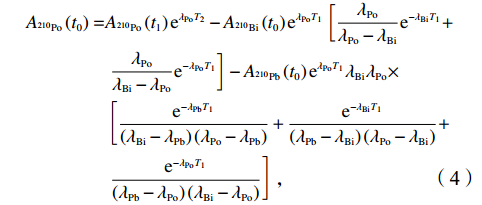


















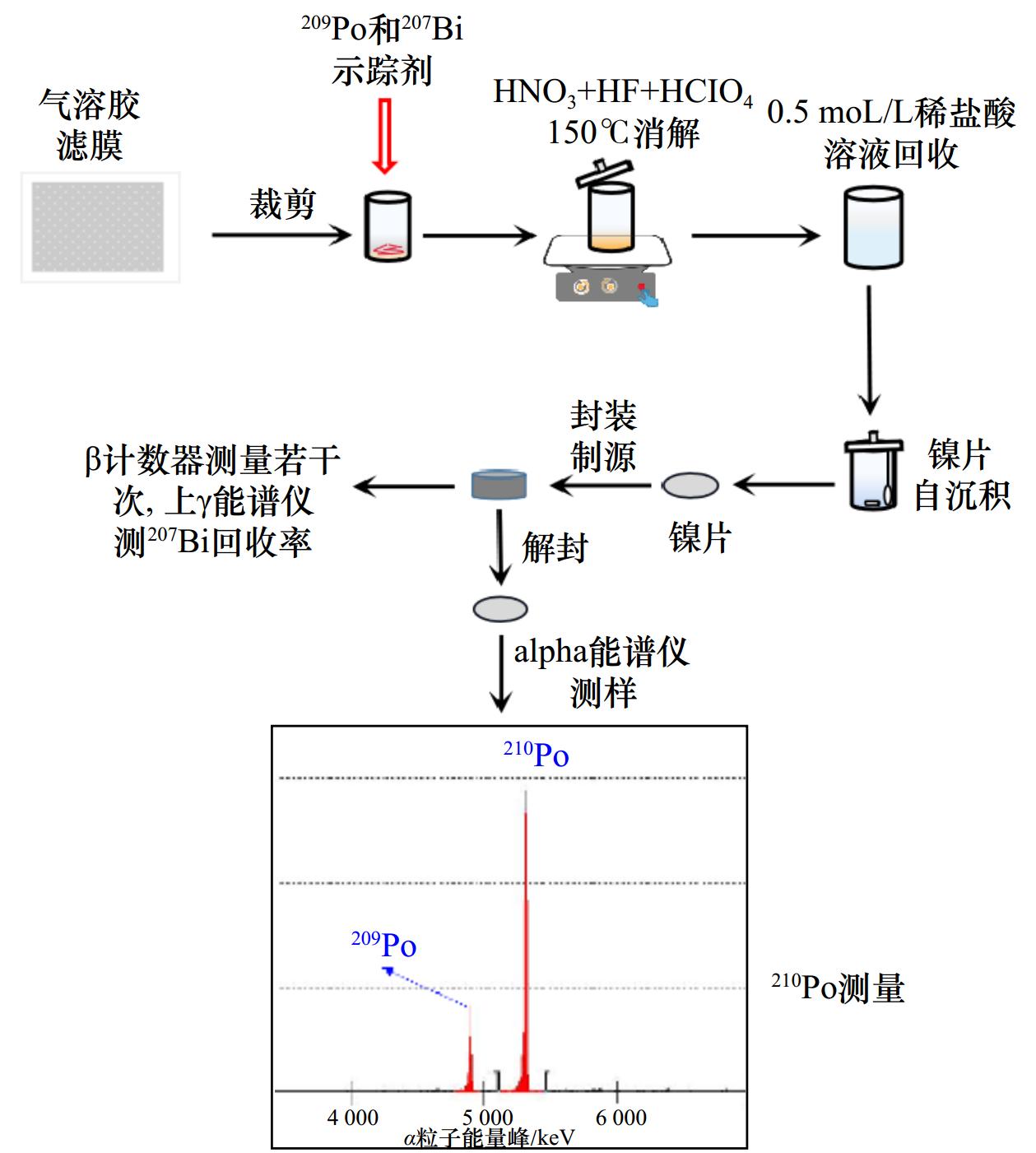
 下载:
下载:
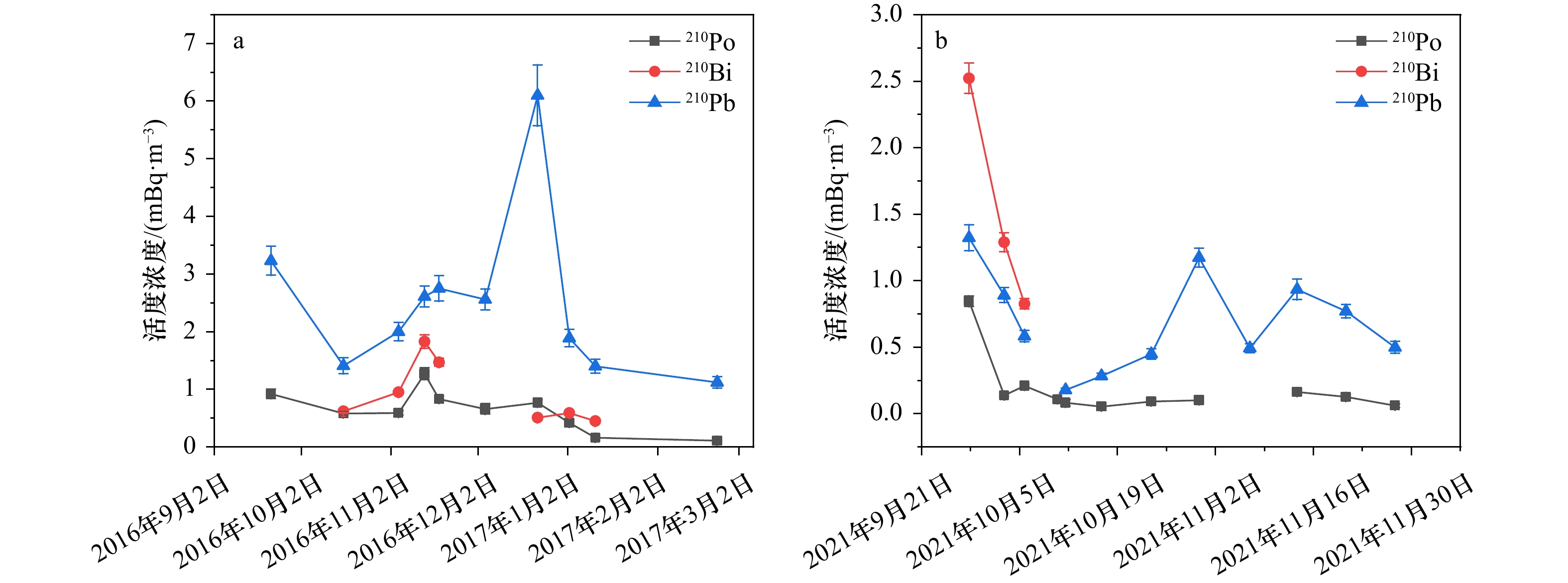

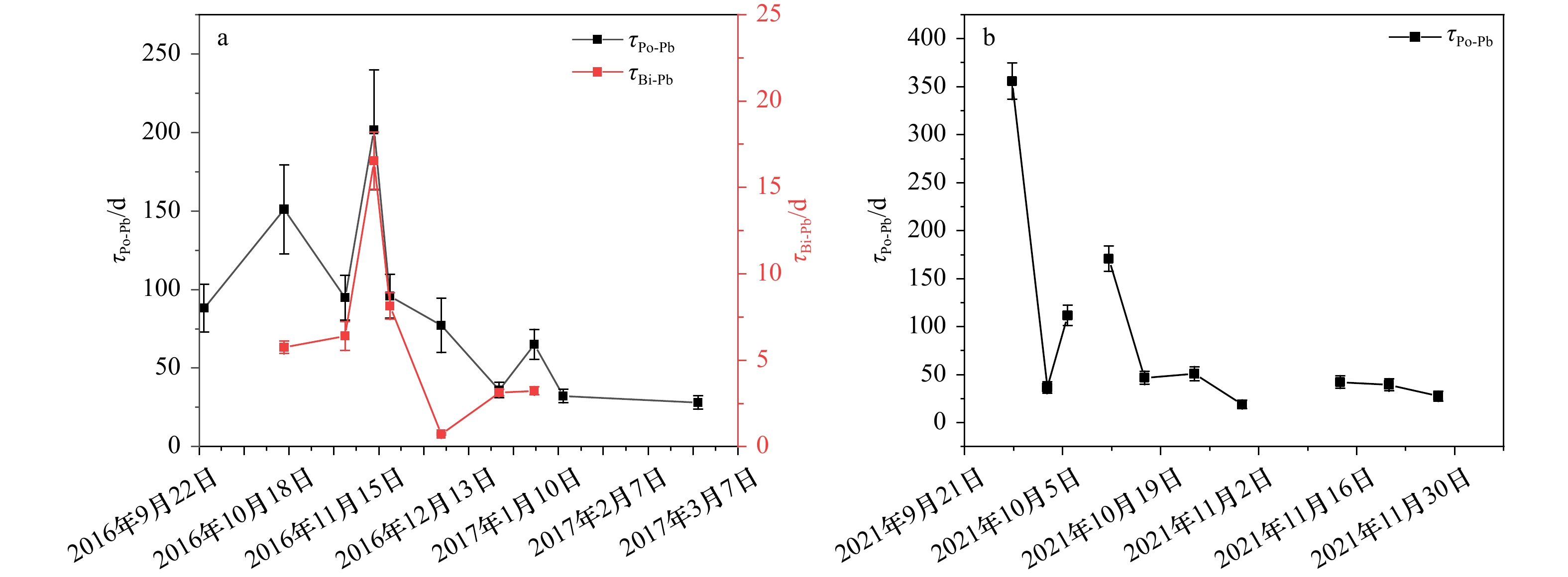
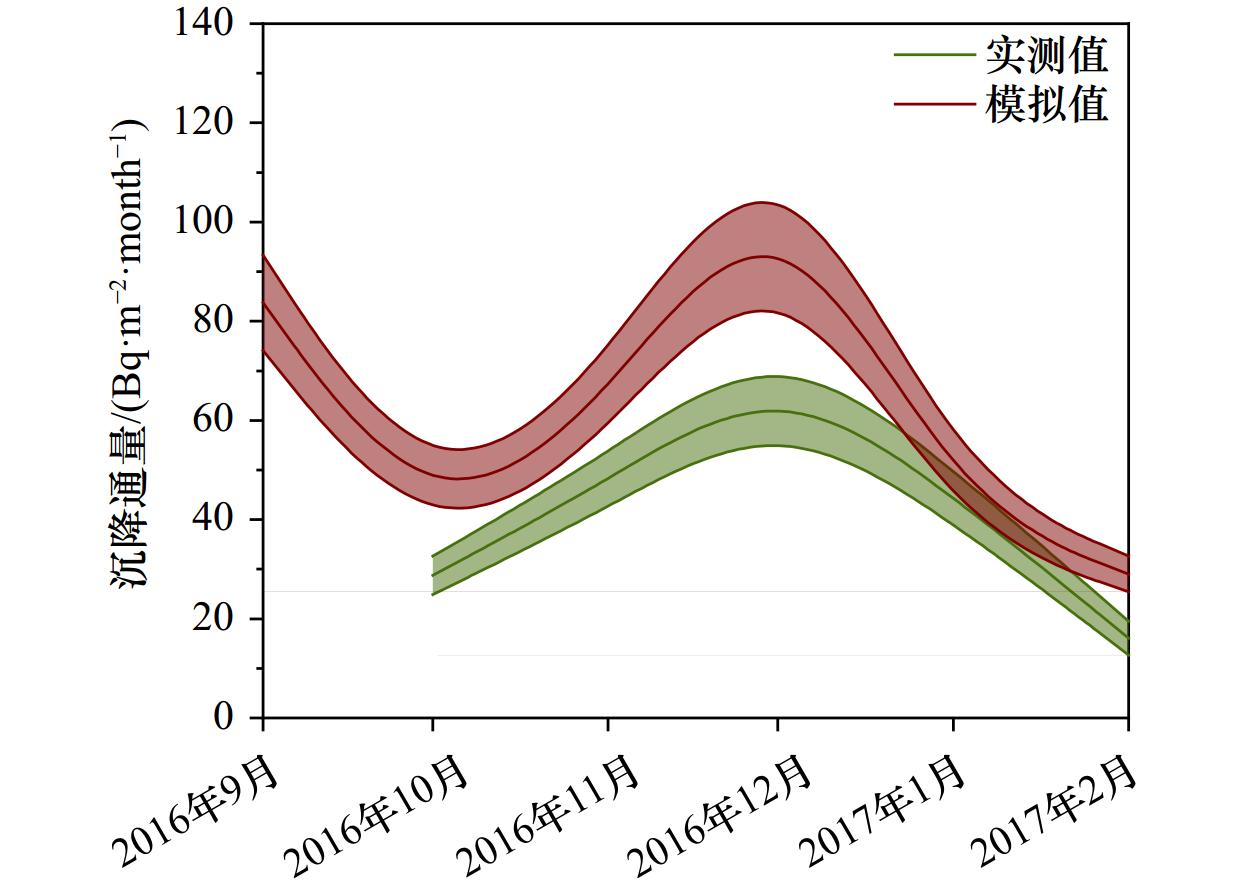
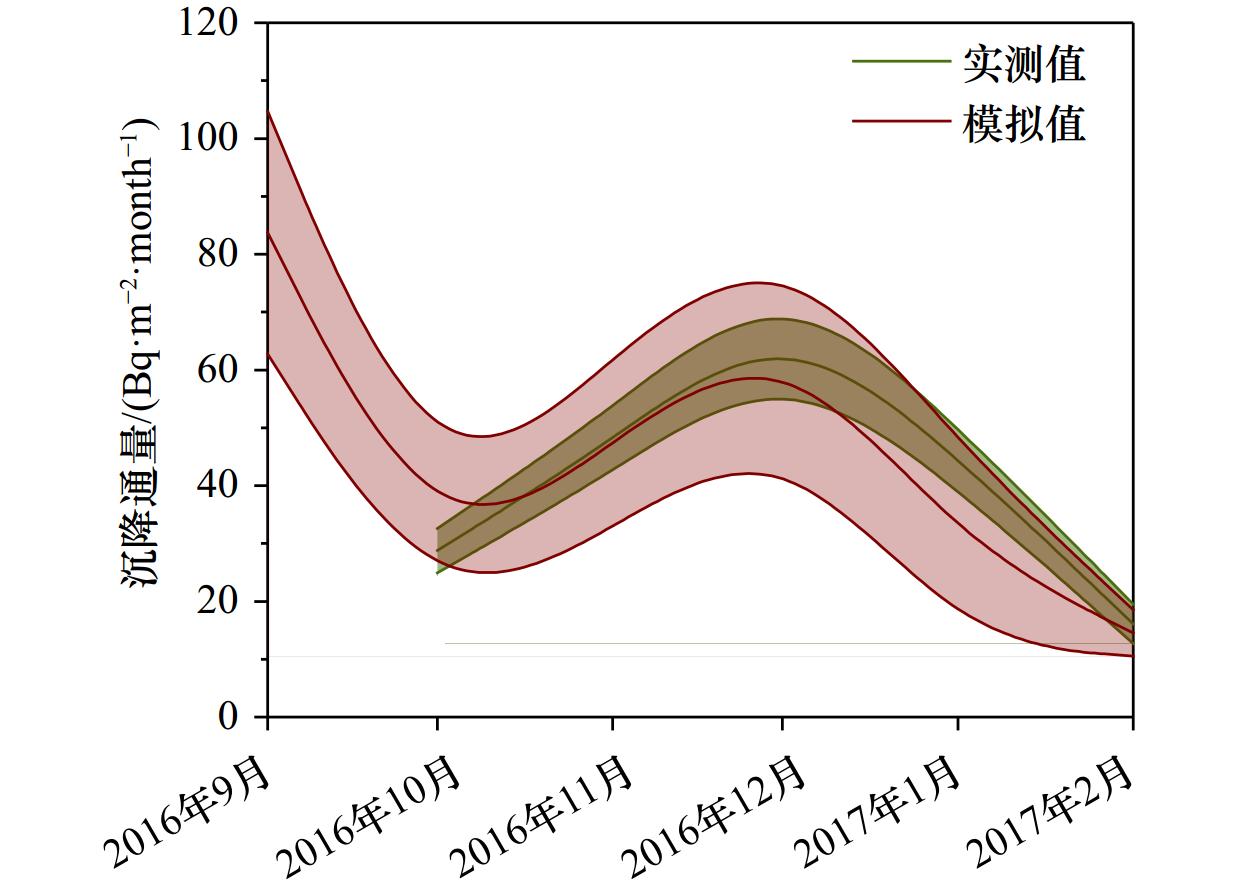
 百度学术
百度学术





